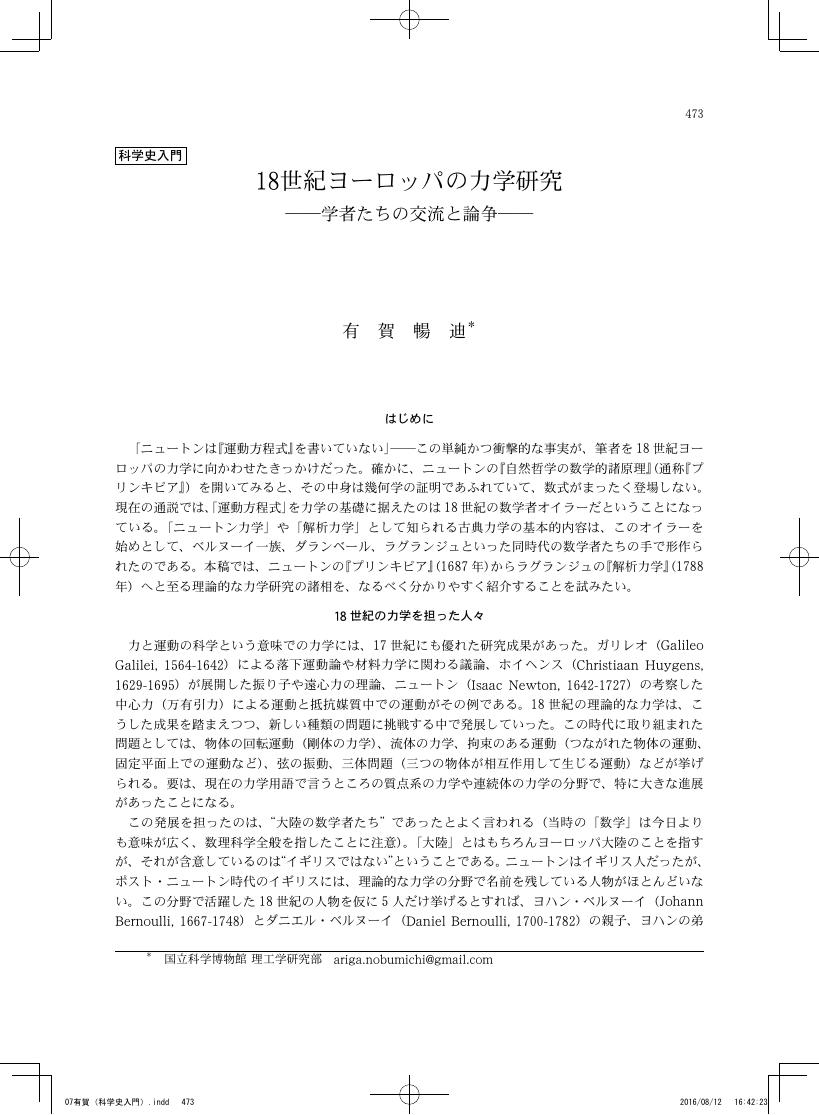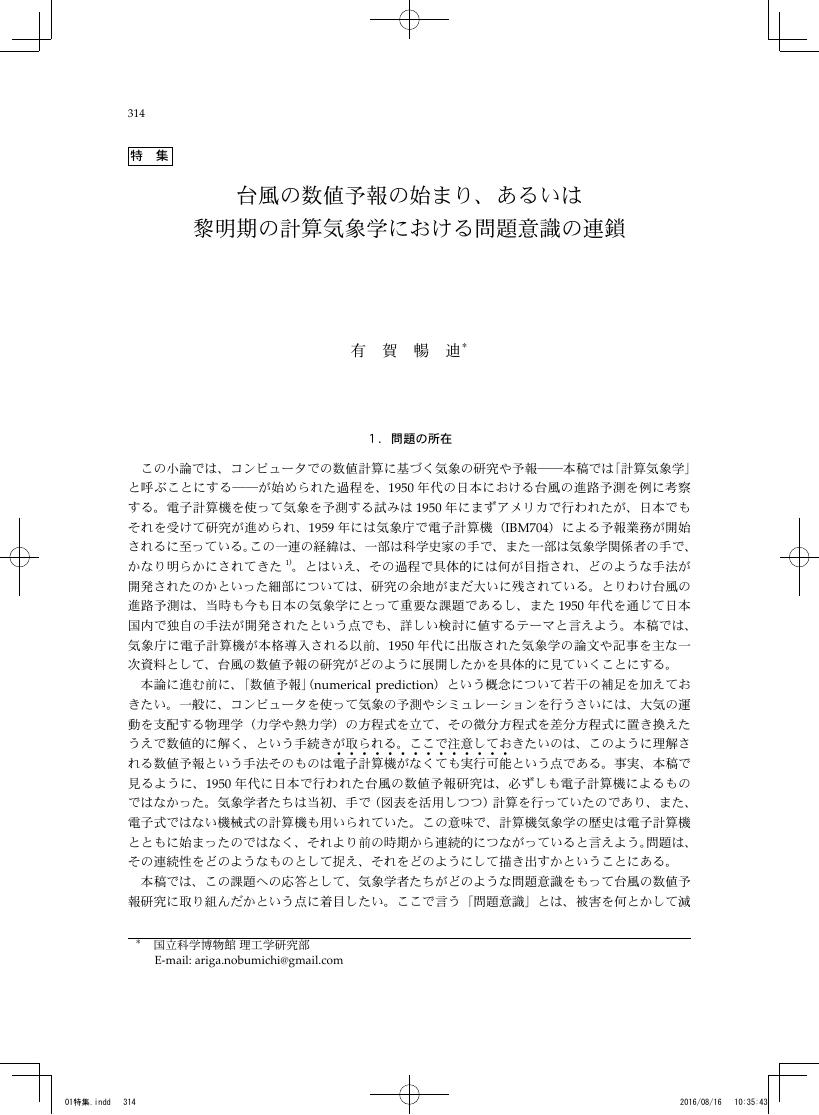- 著者
- 有賀 暢迪
- 出版者
- 京都大学文学部科学哲学科学史研究室
- 雑誌
- 科学哲学科学史研究 (ISSN:18839177)
- 巻号頁・発行日
- vol.2, pp.61-74, 2008-01-31
In 1956, American meteorologist Norman Phillips published an article entitled "The General Circulation of the Atmosphere: A Numerical Experiment," which is considered a landmark in the history of meteorology as well as in that of computer simulation. In this paper, we present Phillips's numerical experiment as a natural development of a dishpan experiment―a laboratory experiment with rotating fluid. Both kinds of experiments are 'model experiments,' and we can regard their models as a tool for understanding general circulation. In the history of meteorology, computer simulation emerged as a kind of experiment.
- 著者
- 有賀 暢迪
- 出版者
- 岩波書店
- 雑誌
- 科学 (ISSN:00227625)
- 巻号頁・発行日
- vol.89, no.6, pp.518-520, 2019-06
- 著者
- 有賀 暢迪
- 出版者
- 岩波書店
- 雑誌
- 科学 (ISSN:00227625)
- 巻号頁・発行日
- vol.89, no.8, pp.693-696, 2019-08
- 著者
- 有賀 暢迪
- 出版者
- 京都大学文学部科学哲学科学史研究室
- 雑誌
- 科学哲学科学史研究 = PHS Studies (ISSN:18839177)
- 巻号頁・発行日
- vol.14, pp.49-68, 2020-04-07
- 著者
- 有賀 暢迪
- 出版者
- 京都大学数理解析研究所
- 雑誌
- 数理解析研究所講究録 (ISSN:18802818)
- 巻号頁・発行日
- vol.1749, pp.16-29, 2011-07
- 著者
- 有賀 暢迪
- 出版者
- 日本科学史学会
- 雑誌
- 科学史研究. [第Ⅲ期] = Journal of history of science, Japan. 日本科学史学会 編 (ISSN:21887535)
- 巻号頁・発行日
- no.272, pp.473-479, 2015-01
2 0 0 0 OA <strong>明治22年(1889年)熊本地震にまつわる資料</strong>
- 著者
- 室谷 智子 有賀 暢迪 若林 文高 大迫 正弘
- 出版者
- 日本地球惑星科学連合
- 雑誌
- 日本地球惑星科学連合2016年大会
- 巻号頁・発行日
- 2016-05-19
明治22年(1889年)7月28日午後11時40分頃,熊本地方で地震が発生し,熊本市内で死者約20名,家屋全壊230棟以上,さらに熊本城の石垣が崩れるなどの被害が発生した.この地震の震源は,熊本市の西部に位置する金峰山で,マグニチュードは6.3と推定され(宇津,1982,BERI),地震発生から21日間で292回,5ヶ月間で566回の余震が観測された(今村,1920,震災予防調査会報告).震源が平成28年(2016年)熊本地震とは少し離れているようであるが,この明治熊本地震への関心は高い.国立科学博物館は,この明治熊本地震に関する資料を所蔵しており,本発表では,それらについて紹介する.熊本市に今も残る冨重写真館の写真師・冨重利平は,明治熊本地震の際,被害の様子を撮影しており,熊本城の石垣の崩壊や,熊本城内にあった陸軍第六師団の被害,墓石の転倒状況,城下町での仮小屋の風景など,11枚の写真を所載した写真帖が国立科学博物館に残されている.写真撮影のポイントは不明であるために完全に同じ場所か分からないが,明治熊本地震で石垣が崩壊した飯田丸や西出丸,平左衛門丸は,平成28年熊本地震でも崩壊している.冨重は軍や県の依頼によって写真を撮影する御用写真師でもあり,軍や県,地震学会の依頼で撮影したものかどうかの経緯は不明であるが,熊本へ震災状況の視察にやってきた侍従に県知事からこれらの写真が寄贈されていることから(水島,1899,熊本明治震災日記),県の依頼で撮影したものかもしれない.これらの写真は,日本の地震被害を写した最初の写真と思われ,国立科学博物館ホームページ「国立科学博物館地震資料室」(http://www.kahaku.go.jp/research/db/science_engineering/namazu/index.html)にて公開している.この地震の際には,帝国大学理科大学(現東京大学理学部)の小藤文次郎や関谷清景,長岡半太郎(当時は大学院生)といった研究者が現地調査を行っている.大きな被害を引き起こした地震の近代的調査としては,この熊本地震がほぼ初めての例となった.地震から11日後の8月8日に現地入りした長岡は,熊本市の西にある金峰山周辺の町村で建物被害や地割れを調べ,ノートや手帳に調査状況や建物被害,地割れ等の被害地点のスケッチを残しており,それらが国立科学博物館に科学者資料として保存されている.古い地震の被害状況を窺い知ることができる資料としては絵図が有効であるが,国立科学博物館では明治熊本地震の絵図も所蔵している.明治22年7月30日印刷,8月出版と記された「熊本県下大地震の実況」絵図は,家屋が倒壊し,下敷きになっている人々が描かれている.また,被害の状況を記す文章も書かれており,「実に近年稀なる大地震なり」と記されている.歴史上,熊本地方は何度も大地震に見舞われているが,平成28年熊本地震が起きた際,過去に熊本で大きな地震が起きたとは知らなかったという人が多かったことからも,被害を伴う地震が稀であるために,大地震について後世に継承されていなかったと思われる.
2 0 0 0 OA <サーベイ論文> 活力論争とは何だったのか
- 著者
- 有賀 暢迪
- 出版者
- 京都大学文学部科学哲学科学史研究室
- 雑誌
- 科学哲学科学史研究 (ISSN:18839177)
- 巻号頁・発行日
- vol.3, pp.39-57, 2009-02-28
2 0 0 0 活力論争を解消する18世紀の試み
- 著者
- 有賀 暢迪
- 出版者
- 日本科学史学会
- 雑誌
- 科学史研究. 第II期 (ISSN:00227692)
- 巻号頁・発行日
- vol.51, no.263, pp.160-169, 2012-09-26
In his classical article "Eighteenth-century attempts to resolve the vis viva controversy" (1965), T. L. Hankins gave a reassessment of the vis viva controversy, dispute about the Cartesian (mv) and Leibnizian (mv^2) measures of "force." Contrary to traditional views, Hankins's and others' works have established that it was not d'Alembert's Traite de dynamique (1743) which put an end to the controversy. But then, when and how did it end? The present article argues that in the middle of the eighteenth-century, some philosophers or mathematicians tried to dissolve the controversy by rejecting its very premise: the concept of "force of bodies in motion." After briefly discussing the popularity of this concept in the vis viva controversy, I will examine claims and thoughts of three personae. D'Alembert's ambition to build the system of mechanics with highest certainty led him to abandon the idea of force in bodies, because it was too "obscure" and too "metaphysical" to serve as the basis. In a similar manner Maupertuis complained about the obscurity of that idea, and with his original principle he aimed at substituting "conservation" of force for "least" action. With regard to Euler, he insisted that force could not be attributed to individual bodies but to their relations, and that force was derived from the nature of bodies such as inertia or impenetrability. Thus it was by rejecting "force of bodies in motion" that the vis viva controversy began to end; not by, as is often said, realizing that both measures were valid.
- 著者
- 有賀 暢迪
- 出版者
- 日本科学史学会
- 雑誌
- 科学史研究. 第II期 (ISSN:00227692)
- 巻号頁・発行日
- vol.50, no.259, pp.150-153, 2011-09-27
1 0 0 0 OA 21pCL-3 スチュワートのエネルギー物理学とその明治日本への導入
- 著者
- 有賀 暢迪
- 出版者
- 一般社団法人 日本物理学会
- 雑誌
- 日本物理学会講演概要集 70.1 (ISSN:21890803)
- 巻号頁・発行日
- pp.3468, 2015-03-21 (Released:2017-07-10)
1 0 0 0 OA 科学史入門 18世紀ヨーロッパの力学研究 : 学者たちの交流と論争
- 著者
- 有賀 暢迪
- 出版者
- 日本科学史学会
- 雑誌
- 科学史研究 (ISSN:21887535)
- 巻号頁・発行日
- vol.53, no.272, pp.473, 2015 (Released:2020-12-14)
1 0 0 0 OA 活力論争を解消する18世紀の試み
- 著者
- 有賀 暢迪
- 出版者
- 日本科学史学会
- 雑誌
- 科学史研究 (ISSN:21887535)
- 巻号頁・発行日
- vol.51, no.263, pp.160-169, 2012 (Released:2021-07-20)
In his classical article "Eighteenth-century attempts to resolve the vis viva controversy" (1965), T. L. Hankins gave a reassessment of the vis viva controversy, dispute about the Cartesian (mv) and Leibnizian (mv^2) measures of "force." Contrary to traditional views, Hankins's and others' works have established that it was not d'Alembert's Traite de dynamique (1743) which put an end to the controversy. But then, when and how did it end? The present article argues that in the middle of the eighteenth-century, some philosophers or mathematicians tried to dissolve the controversy by rejecting its very premise: the concept of "force of bodies in motion." After briefly discussing the popularity of this concept in the vis viva controversy, I will examine claims and thoughts of three personae. D'Alembert's ambition to build the system of mechanics with highest certainty led him to abandon the idea of force in bodies, because it was too "obscure" and too "metaphysical" to serve as the basis. In a similar manner Maupertuis complained about the obscurity of that idea, and with his original principle he aimed at substituting "conservation" of force for "least" action. With regard to Euler, he insisted that force could not be attributed to individual bodies but to their relations, and that force was derived from the nature of bodies such as inertia or impenetrability. Thus it was by rejecting "force of bodies in motion" that the vis viva controversy began to end; not by, as is often said, realizing that both measures were valid.
- 著者
- 有賀 暢迪
- 出版者
- 日本科学史学会
- 雑誌
- 科学史研究 (ISSN:21887535)
- 巻号頁・発行日
- vol.50, no.259, pp.150-153, 2011 (Released:2021-07-21)
- 著者
- 有賀 暢迪
- 出版者
- 日本科学史学会
- 雑誌
- 科学史研究 (ISSN:21887535)
- 巻号頁・発行日
- vol.48, no.250, pp.77-86, 2009 (Released:2021-08-04)
The principle of least action owes its modern formulation to Lagrange (1736-1813), who also related its "pre-modern" history in his Mechanique analitique (1788): Maupertuis (1698-1759) treated it in an ambiguous manner, while Euler (1707-1783) formulated it more precisely. Recent historical studies have shown, however, the difficulty of maintaining this narrative, for these two scholars departed from different problems and reached at different formulations of the principle. In general agreement with these views, this paper emphasizes a further, crucial distinction between Maupertuis and Euler-their usage of the term "quantity of action." When Maupertuis spoke of "quantity of action," he referred to a product of mass, velocity and distance, and his main concern was with the instanteneous change of two bodies colliding. Euler, on the other hand, investigated various "mechanical curves" under the continuous action of forces, searching for a quantity which was minimum to these curves. He realized then that these minimum quantites could be derived from a single one, which he named "effort." Euler did not accept Maupertuis's definition of the "quantity of action" but identified it with the "effort." Although Euler had acquired the idea of "effort" from Maupertuis's earlier work on the "law of rest," Maupertuis himself did not appraise it so highly. They disagreed over what "quantity of action" meant, and their disagreement was related to the kind of physical problems with which they were concerned; before Lagrange's modern formulation, there were two quite distinct principles of least action.
1 0 0 0 OA シンポジウム:古典力学の展開 オイラー生誕300年を記念して-2007年度年会報告-
1 0 0 0 OA オイラーの変分力学
- 著者
- 有賀 暢迪
- 出版者
- 日本科学史学会
- 雑誌
- 科学史研究 (ISSN:21887535)
- 巻号頁・発行日
- vol.45, no.240, pp.220-228, 2006 (Released:2021-08-11)
Although newtonian mechanics is the most familiar formulation of classical mechanics, we have an another one called variational mechanics. Leonhard Euler attempted to solve some mechanical problems using the latter idea and gave two variational-mechanical laws : "law of rest " in statics, and "law of motion " in dynamics. He maintained that these two laws were "in harmony ", namely that the one could be derived from the other. Moreover, they are both based on "principle of least action, " according to which some quantities are minimum in physical phenomena. In effect, "law of rest " asserts that the sum of "efforts " for bodies is minimum in equilibrium, which Euler interprets as the evidence of the intention of nature to "save efforts. " "Law of motion " determines the trajectory of a mass point, in which "action " is minimum; according to Euler, this could be explained by the inertia of bodies. These laws show Euler's faith in his principle, even though he doesn't use the condition of "minimum " in solving concrete problems; therefore, his "principle of least action " is not a mathmatical requirement. His demonstration of the "harmony " is also based on the belief that nature "saves efforts. " This attempt is, however, a failure in a double meaning; we can't prove the "harmony " from the point of modern view, and Euler's proof is inconsistent with his own "principle of least action. " "Euler's variational mechanics " has failed to realize a unified treatment of statics and dynamics, because it was built up on the "principle of least action. "
1 0 0 0 領域横断的な万国博覧会史研究を通じた新しい戦後史叙述の可能性
本研究は、研究史の空隙となっている第二次大戦後の万国博覧会史に取り組むものであり、時期的対象は、万博を統括する政府間組織BIE(在パリ、1931年発足)が大戦終結を受けて活動を再開した1945年から、植民地独立を主要因とする国際社会の変容を背景に、今日も有効な万博の新定義を打ち出すに至った1994年までである。その目的は、催事としての万博それ自体を詳解することではなく、万博史研究というレンズを通じて、国際情勢から開催・参加各国内の政局、関係業界の動向、関係者個々人のミクロな経験までを途切れなく見通し、かつ、自ずと世界の多様な視点に立脚する、新たな戦後世界史叙述の可能性を提示することにある。
- 著者
- 有賀 暢迪
- 出版者
- 日本科学史学会
- 雑誌
- 科学史研究 (ISSN:21887535)
- 巻号頁・発行日
- vol.54, no.276, pp.314, 2016 (Released:2021-01-05)




